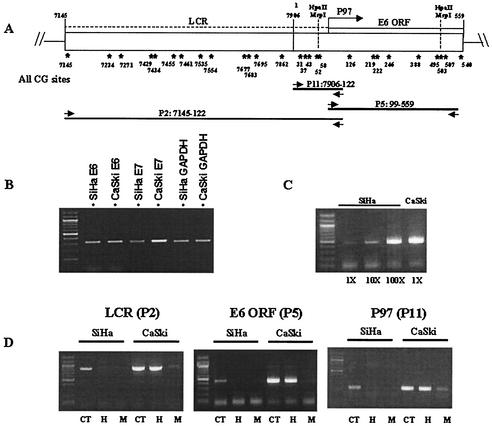FIG. 1.
HpaII/MspI cleavage identifies CpG methylation of SiHa and CaSki DNA as a likely source of transcriptional repression. (A) Distribution of CpGs in the LCR (positions 7154 to 7906 and 1 to 96) and in the E6 gene of HPV-16 (positions 97 to 559) and positions of two HpaII/MspI sites, one (position 57) overlapping with elements of the E6 promoter P97 and the other located in the 3′ part of the E6 gene (position 502). (B) Reverse transcription-PCR confirms that similar amounts of E6 and E7 transcripts are generated by SiHa and CaSki cells. GAPDH, glyceraldehyde-3-phosphate dehydrogenase, served as the cellular control transcript. (C) Genomic PCR confirms the large excess of HPV-16 DNA in CaSki cells. (D) Chromosomal DNA of SiHa and CaSki cells was not cut (CT, control) or was cleaved with one of the two enzymes (H, HpaII; M, MspI) and PCR amplified to generate the amplicons P2, P5, and P11. None of the three amplicons could be generated after cleavage with either of the two enzymes in the case of SiHa cells, indicating lack of any methylated CCGG sequences. In the case of CaSki cells, most of the DNA was resistant to HpaII digestion but was readily cleaved by MspI, indicating methylation of these two sites in most of the 500 HPV-16 copies in CaSki cells.

